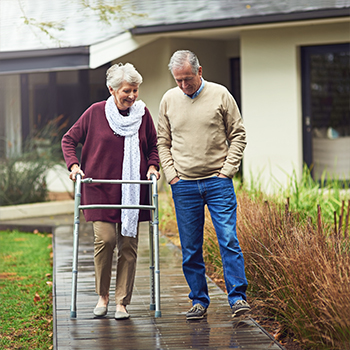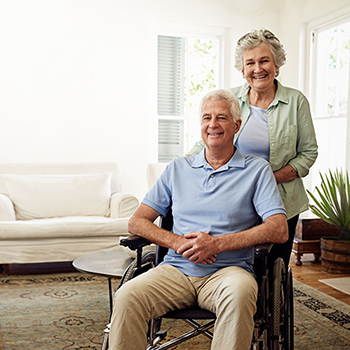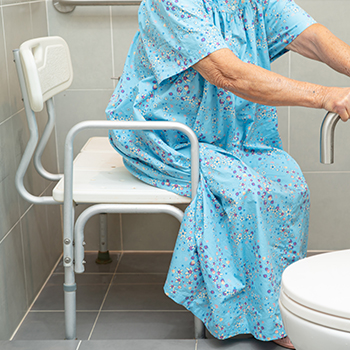
Mobility is a vital aspect of life, health, and aging. As we age, facing mobility problems in elderly individuals becomes increasingly common, often significantly impacting their daily living. Understanding these challenges is crucial for providing the right support and care. This blog aims to discuss common elderly mobility issues and offer insights into how we can help seniors improve their quality of life.
Understanding How Elderly Mobility Issues Affect Their Daily Living
Elderly mobility issues are about more than just improving balance and activity levels. Maintaining mobility profoundly affect every aspect of daily life. Due to aging, many older people face a fear of falling due to issues with strength and balance. As mobility declines, the simple act of getting out of bed to navigating through the house, mobility problems in elderly individuals can drastically limit an senior’s independence and freedom. These issues often lead to a higher risk for falling, injuries, and a decreased ability to perform daily tasks, resulting in a significant impact on their mental and emotional well-being. The loss of mobility can lead to feelings of dependence, frustration, and isolation, profoundly affecting seniors’ overall quality of life.
10 Common Mobility Problems in Elderly
- Arthritis, a condition common among older people, can greatly influence their ability to move. This condition causes pain and stiffness in joints, severely limiting movement.
- Osteoporosis. Weakening of bones, making them more prone to fractures.
- Balance Disorders, prevalent in those over the age of 65, can significantly affect mobility among older adults. Increases the risk of falls due to unsteady walking.
- Muscle Weakness. Decreased muscle strength leading to difficulty in movements.
- Parkinson’s Disease, a condition prevalent among older people. A neurological condition that affects movement control.
- Stroke. Can lead to one-sided paralysis or weakness, impacting mobility in aging.
- Vision Loss. Poor vision contributes to a higher risk of tripping or falling, exacerbating mobility problems in seniors.
- Diabetes Complications. Can cause nerve damage among older individuals that affects their gait and overall mobility functions.
- Joint Replacement Surgery. Recovery post illnesses, particularly among the age 65 and above, can temporarily reduce mobility.
- Cardiovascular Diseases, common in people over age 65, can impact physical function and mobility. Limit stamina and endurance, affecting movement.
“The loss of mobility can lead to feelings of dependence, frustration, and isolation, profoundly affecting seniors’ overall quality of life.”
Tips on How to Improve Mobility in Elderly
Improving mobility in elderly individuals is crucial for maintaining their independence and quality of life. Here are some tips to help increase mobility:
- Engage in an Exercise Program. Encourage gentle exercises like walking, swimming, or tai chi to keep joints and muscles active.
- Healthy Diet. A diet rich in calcium and vitamin D can strengthen older people’s bones.
- Fall-proofing the Home. Make modifications like installing grab bars and removing tripping hazards can help prevent falls.
- Regular Health Check-ups are essential times to perform mobility assessments. Early detection of conditions that may lead to mobility problems in elderly individuals can make a significant difference.
- Physical Therapy, often beneficial for people over the age of 65, can help address mobility limitations. Professional guidance to improve strength, balance, and coordination.
Adaptive Solutions, Products, and Aids on Mobility for Seniors
Adaptive solutions play a pivotal role in enhancing mobility for elderly people. These tools are designed to assist with various elderly mobility issues, allowing for safer and more independent living. Key adaptive aids include.
Walking Aids
Walking aids such as a canes or walker are essential for many seniors facing mobility problems in elderly years. They provide necessary support and stability, helping with fall prevention and enabling easier movement around the home and outdoors.


Wheelchairs and Scooters
For seniors with more severe mobility issues, wheelchairs and motorized scooters can be life-changing. They offer an increased ability to move around and the ability to travel longer distances, ensuring that mobility for seniors doesn’t have to be significantly limited.
Adaptive Clothing and Footwear
Adaptive clothing and footwear are designed with the elderly in mind, focusing on improved quality of life and improved independence. These items often include features like Velcro closures and non-slip soles, catering to various elderly mobility issues.


Bathroom Aids
Bathroom aids, such as shower chairs and raised toilet seats, are crucial in preventing falls in older populations. These aids provide stability and support in a typically slippery and accident-prone area of the home.
Home Modifications
Home modifications like installing ramps, stairlifts, and non-slip flooring can significantly improve home safety as people age. These modifications address various aspects of mobility problems in seniors, making their living environment safer and more accessible.

Each of these adaptive solutions plays a vital role in managing and improving mobility issues among the elderly, enhancing their safety and quality of life.
Engaging with Healthcare Professionals on Mobility for Seniors
Collaboration with healthcare professionals is crucial in preventing mobility risk in older people. Regular consultations can lead to personalized plans that include physical therapy, medication adjustments, strength training and specific exercises tailored to individual needs, particularly beneficial for those over the age of 65. Healthcare professionals can also guide the selection of appropriate adaptive tools and modifications to ensure they effectively address the mobility problems in seniors and enhance their ability to move.
Case Studies and Expert Insights
To illustrate the impact of these interventions, consider the case of Mr. Johnson, a 78-year-old with arthritis. After incorporating recommended arthritis exercises for older people into his routine, and using a walker, Mr. Johnson’s mobility and confidence dramatically enhanced. Similarly, Mrs. Smith, who struggled with balance issues, benefited from home modifications and physical therapy, resulting in a marked decrease in falls and enhanced independence.
Introducing Christian Provider Service
Addressing mobility problems in elderly individuals requires a compassionate and comprehensive approach. Christian Provider Service steps in to help older people struggling with reduced physical function. As a provider of home health services, we are dedicated to improving the lives of our elderly community. Our services, including physical therapy, daily activity assistance, and guidance on using adaptive aids, are tailored to meet the unique needs of seniors. By improving mobility in older individuals we strive to enhance their independence and quality of life. Contact us today to discuss your situation.

